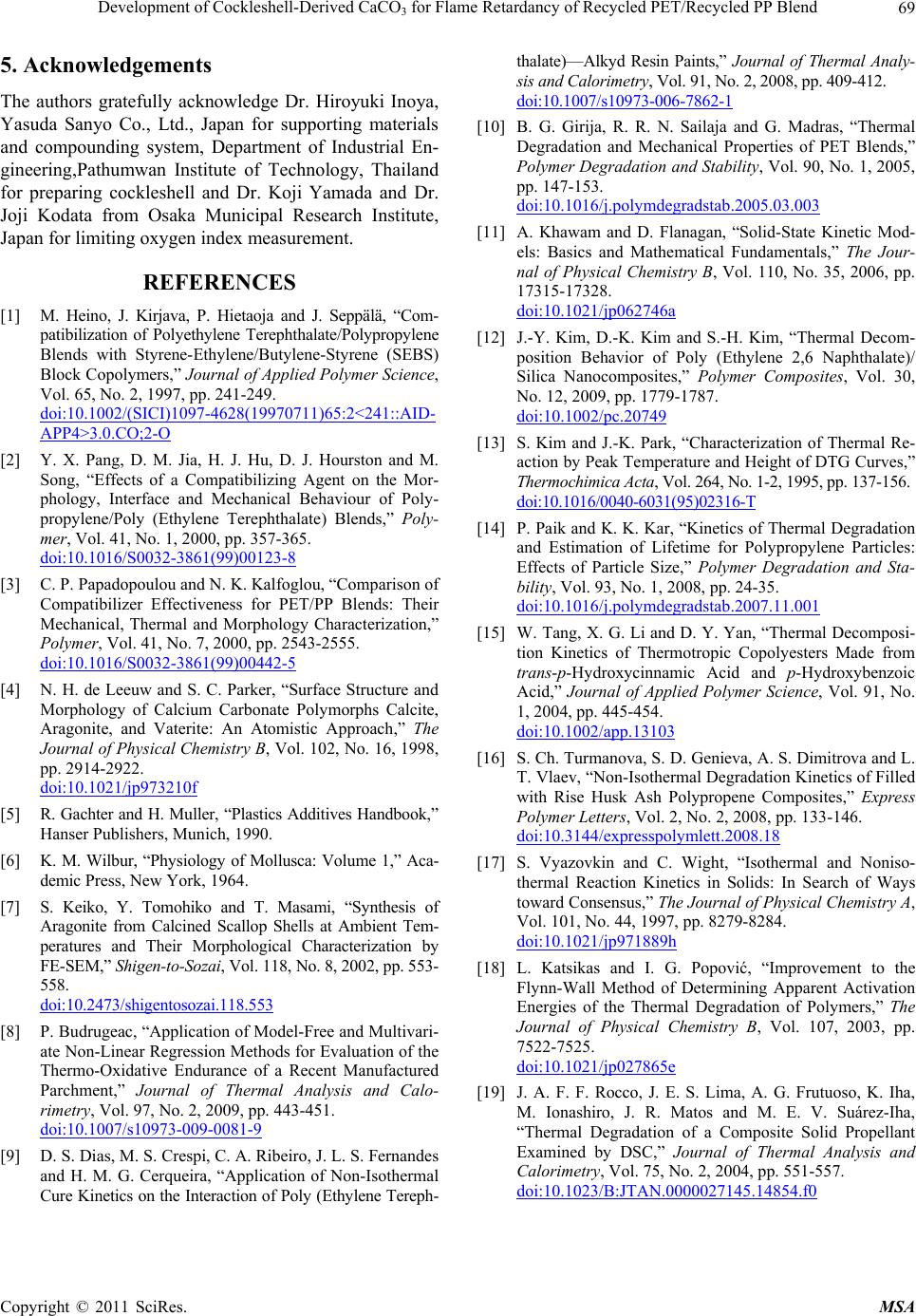
Development of Cockleshell-Derived CaCO for Flame Retardancy of Recycled PET/Recycled PP Blend69
3
5. Acknowledgements
The authors gratefully acknowledge Dr. Hiroyuki Inoya,
Yasuda Sanyo Co., Ltd., Japan for supporting materials
and compounding system, Department of Industrial En-
gineering,Pathumwan Institute of Technology, Thailand
for preparing cockleshell and Dr. Koji Yamada and Dr.
Joji Kodata from Osaka Municipal Research Institute,
Japan for limiting oxygen index measurement.
REFERENCES
[1] M. Heino, J. Kirjava, P. Hietaoja and J. Seppälä, “Com-
patibilization of Polyethylene Terephthalate/Polypropylene
Blends with Styrene-Ethylene/Butylene-Styrene (SEBS)
Block Copolymers,” Journal of Applied Polymer Science,
Vol. 65, No. 2, 1997, pp. 241-249.
doi:10.1002/(SICI)1097-4628(19970711)65:2<241::AID-
APP4>3.0.CO;2-O
[2] Y. X. Pang, D. M. Jia, H. J. Hu, D. J. Hourston and M.
Song, “Effects of a Compatibilizing Agent on the Mor-
phology, Interface and Mechanical Behaviour of Poly-
propylene/Poly (Ethylene Terephthalate) Blends,” Poly-
mer, Vol. 41, No. 1, 2000, pp. 357-365.
doi:10.1016/S0032-3861(99)00123-8
[3] C. P. Papadopoulou and N. K. Kalfoglou, “Comparison of
Compatibilizer Effectiveness for PET/PP Blends: Their
Mechanical, Thermal and Morphology Characterization,”
Polymer, Vol. 41, No. 7, 2000, pp. 2543-2555.
doi:10.1016/S0032-3861(99)00442-5
[4] N. H. de Leeuw and S. C. Parker, “Surface Structure and
Morphology of Calcium Carbonate Polymorphs Calcite,
Aragonite, and Vaterite: An Atomistic Approach,” The
Journal of Physical Chemistry B, Vol. 102, No. 16, 1998,
pp. 2914-2922.
doi:10.1021/jp973210f
[5] R. Gachter and H. Muller, “Plastics Additives Handbook,”
Hanser Publishers, Munich, 1990.
[6] K. M. Wilbur, “Physiology of Mollusca: Volume 1,” Aca-
demic Press, New York, 1964.
[7] S. Keiko, Y. Tomohiko and T. Masami, “Synthesis of
Aragonite from Calcined Scallop Shells at Ambient Tem-
peratures and Their Morphological Characterization by
FE-SEM,” Shige n-to-So zai, Vol. 118, No. 8, 2002, pp. 553-
558.
doi:10.2473/shigentosozai.118.553
[8] P. Budrugeac, “Application of Model-Free and Multivari-
ate Non-Linear Regression Methods for Evaluation of the
Thermo-Oxidative Endurance of a Recent Manufactured
Parchment,” Journal of Thermal Analysis and Calo-
rimetry, Vol. 97, No. 2, 2009, pp. 443-451.
doi:10.1007/s10973-009-0081-9
[9] D. S. Dias, M. S. Crespi, C. A. Ribeiro, J. L. S. Fernandes
and H. M. G. Cerqueira, “Application of Non-Isothermal
Cure Kinetics on the Interaction of Poly (Ethylene Tereph-
thalate)—Alkyd Resin Paints,” Journal of Thermal Analy-
sis and Calorimetry, Vol. 91, No. 2, 2008, pp. 409-412.
doi:10.1007/s10973-006- 7862-1
[10] B. G. Girija, R. R. N. Sailaja and G. Madras, “Thermal
Degradation and Mechanical Properties of PET Blends,”
Polymer Degradation and Stability, Vol. 90, No. 1, 2005,
pp. 147-153.
doi:10.1016/j.polymdegradstab.2005.03.003
[11] A. Khawam and D. Flanagan, “Solid-State Kinetic Mod-
els: Basics and Mathematical Fundamentals,” The Jour-
nal of Physical Chemistry B, Vol. 110, No. 35, 2006, pp.
17315-17328.
doi:10.1021/jp062746a
[12] J.-Y. Kim, D.-K. Kim and S.-H. Kim, “Thermal Decom-
position Behavior of Poly (Ethylene 2,6 Naphthalate)/
Silica Nanocomposites,” Polymer Composites, Vol. 30,
No. 12, 2009, pp. 1779-1787.
doi:10.1002/pc.20749
[13] S. Kim and J.-K. Park, “Characterization of Thermal Re-
action by Peak Temperature and Height of DTG Curves,”
Thermochimica Acta, Vol. 264, No. 1-2, 1995, pp. 137-156.
doi:10.1016 /0 04 0 -60 31(95)0231 6- T
[14] P. Paik and K. K. Kar, “Kinetics of Thermal Degradation
and Estimation of Lifetime for Polypropylene Particles:
Effects of Particle Size,” Polymer Degradation and Sta-
bility, Vol. 93, No. 1, 2008, pp. 24-35.
doi:10.1016/j.polymdegradstab.2007.11.001
[15] W. Tang, X. G. Li and D. Y. Yan, “Thermal Decomposi-
tion Kinetics of Thermotropic Copolyesters Made from
trans-p-Hydroxycinnamic Acid and p-Hydroxybenzoic
Acid,” Journal of Applied Polymer Science, Vol. 91, No.
1, 2004, pp. 445-454.
doi:10.1002/app.13103
[16] S. Ch. Turmanova, S. D. Genieva, A. S. Dimitrova and L.
T. Vlaev, “Non-Isothermal Degradation Kinetics of Filled
with Rise Husk Ash Polypropene Composites,” Express
Polymer Letters, Vol. 2, No. 2, 2008, pp. 133-146.
doi:10.3144/expresspolymlett.2008.18
[17] S. Vyazovkin and C. Wight, “Isothermal and Noniso-
thermal Reaction Kinetics in Solids: In Search of Ways
toward Consensus,” The Journal of Physical Chemistry A,
Vol. 101, No. 44, 1997, pp. 8279-8284.
doi:10.1021/jp971889h
[18] L. Katsikas and I. G. Popović, “Improvement to the
Flynn-Wall Method of Determining Apparent Activation
Energies of the Thermal Degradation of Polymers,” The
Journal of Physical Chemistry B, Vol. 107, 2003, pp.
7522-7525.
doi:10.1021/jp027865e
[19] J. A. F. F. Rocco, J. E. S. Lima, A. G. Frutuoso, K. Iha,
M. Ionashiro, J. R. Matos and M. E. V. Suárez-Iha,
“Thermal Degradation of a Composite Solid Propellant
Examined by DSC,” Journal of Thermal Analysis and
Calorimetry, Vol. 75, No. 2, 2004, pp. 551-557.
doi:10.1023/B:JTAN.0000027145.14854.f0
Copyright © 2011 SciRes. MSA